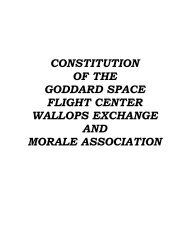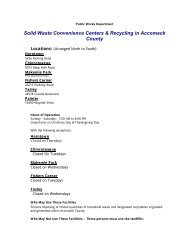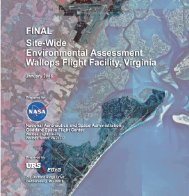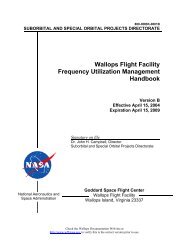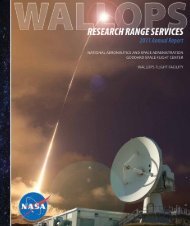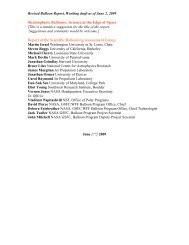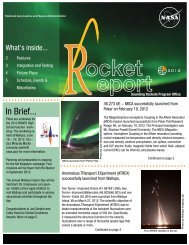NASA POKER FLAT EIS
NASA POKER FLAT EIS
NASA POKER FLAT EIS
You also want an ePaper? Increase the reach of your titles
YUMPU automatically turns print PDFs into web optimized ePapers that Google loves.
APPENDIX D<br />
ALASKA NATIONAL INTEREST LANDS CONSERVATION ACT SECTION 810(A)<br />
SUMMARY OF EVALUATIONS AND FINDINGS
This page intentionally left blank.
APPENDIX D.<br />
ALASKA NATIONAL INTEREST LANDS CONSERVATION ACT<br />
SECTION 810(A) SUMMARY OF EVALUATIONS<br />
AND FINDINGS<br />
D.1 INTRODUCTION<br />
This summary of evaluations and findings has been prepared to comply with the requirements<br />
incumbent upon the U.S. Fish and Wildlife Service and Bureau of Land Management as<br />
established by Title VIII, Section 810, of the Alaska National Interest Lands Conservation Act<br />
(ANILCA). It evaluates the potential restrictions on subsistence activities that could result from<br />
implementation of the alternatives considered in the National Aeronautics and Space<br />
Administration (<strong>NASA</strong>’s) Draft Environmental Impact Statement for the Sounding Rockets<br />
Program at Poker Flat Research Range (PFRR <strong>EIS</strong>).<br />
As described in this environmental impact statement (<strong>EIS</strong>), the <strong>NASA</strong> Sounding Rockets<br />
Program (SRP) has conducted missions from Poker Flat Research Range (PFRR) in interior<br />
Alaska since the late 1960s. This <strong>EIS</strong> evaluates four action alternatives that include continuation<br />
of the SRP at PFRR with varying amounts of search and recovery to retrieve payloads and spent<br />
rocket stages. This <strong>EIS</strong> also evaluates a No Action Alternative, in which SRP operations,<br />
including launches and subsequent search and recovery efforts, would continue as currently<br />
conducted.<br />
Chapters 3 and 4 of this <strong>EIS</strong> provide a detailed description of the baseline conditions and the<br />
potential adverse effects on subsistence of the alternatives. The analysis in this appendix<br />
leverages the detailed information presented in this <strong>EIS</strong> to evaluate the potential impacts on<br />
subsistence pursuant to Section 810(a) of ANILCA.<br />
D.2 THE EVALUATION PROCESS<br />
Section 810(a) of ANILCA states:<br />
“In determining whether to withdraw, reserve, lease, or otherwise permit the use,<br />
occupancy, or disposition of public lands…the head of the Federal agency…over<br />
such lands…shall evaluate the effect of such use, occupancy, or disposition on<br />
subsistence uses and needs, the availability of other lands for the purposes sought<br />
to be achieved, and other alternatives which would reduce or eliminate the use,<br />
occupancy, or disposition of public lands needed for subsistence purposes. No<br />
such withdrawal, reservation, lease, permit, or other use, occupancy or disposition<br />
of such lands that would significantly restrict subsistence uses shall be affected<br />
until the head of such Federal agency:<br />
1. gives notice to the appropriate State agency and the appropriate local<br />
committees and regional councils established pursuant to Section 805;<br />
SEPTEMBER 2012 D–1
Draft Environmental Impact Statement for the Sounding Rockets Program at Poker Flat Research Range<br />
2. gives notice of, and holds, a hearing in the vicinity of the area involved; and<br />
3. determines that (a) such a significant restriction of subsistence uses is<br />
necessary, consistent with sound management principles for the utilization of<br />
the public lands, (b) the proposed activity would involve the minimal amount<br />
of public lands necessary to accomplish the purposes of such use, occupancy,<br />
or other disposition, and (c) reasonable steps would be taken to minimize<br />
adverse impacts upon subsistence uses and resources resulting from such<br />
actions.”<br />
To determine if a significant restriction of subsistence uses and needs may result from any one of<br />
the alternatives discussed in this <strong>EIS</strong>, the following three factors in particular are considered:<br />
A reduction in subsistence uses due to factors such as direct impacts on the resource,<br />
adverse impacts on habitat, or increased competition for the resources;<br />
A reduction in the subsistence uses due to changes in the availability of resources caused<br />
by an alteration in their distribution, migration, or location; and<br />
A reduction in subsistence uses due to limitations on the access to harvestable resources<br />
such as physical or legal barriers.<br />
Subsistence evaluations and findings under ANILCA Section 810 also must consider cumulative<br />
impacts. In the context of this evaluation, cumulative impacts are additive limitations on<br />
subsistence uses or resources caused by the proposed alternatives when considered within the<br />
context of past, present, and future activities affecting those same uses or resources. Cumulative<br />
impacts are discussed in Chapter 4, Section 4.1.5, of this <strong>EIS</strong>.<br />
When analyzing the effects of the five alternatives, those villages that may harvest subsistence<br />
resources within or adjacent to the PFRR flight zones are considered (see Section D.4, below).<br />
D.3 PROPOSED ACTION ON FEDERAL LANDS<br />
Chapter 2 of this <strong>EIS</strong> (“Description and Comparison of Alternatives”) describes in detail the<br />
alternatives under consideration. Following is a brief summary of each. The primary focus of<br />
activity would take place within the PFRR flight zones, which include Federal, state, and Tribal<br />
lands.<br />
Under either alternative, the use of Federal lands would be required for the landing and recovery<br />
of flight hardware. As such, the U.S. Fish and Wildlife Service (USFWS) and the U.S. Bureau of<br />
Land Management would be required to respond to a request for such authorization, thereby<br />
taking an action connected to those alternatives proposed by <strong>NASA</strong> below.<br />
D–2 SEPTEMBER 2012
D ▪ ANILCA Section 810(a) Summary of Evaluations and Findings<br />
D.3.1 No Action Alternative – Continue <strong>NASA</strong> SRP at PFRR in its Present Form<br />
and at the Current Level of Effort<br />
Under the No Action Alternative, the SRP activities at PFRR would continue in their present<br />
form and at the current level of effort (approximately four launches per year). <strong>NASA</strong> would<br />
continue to avoid the Mollie Beattie Wilderness Area within Arctic NWR. Under this<br />
alternative, no significant efforts would be taken to recover spent stages unless desired for<br />
programmatic reasons, and payloads would be recovered as planned by the scientists. See<br />
Chapter 2, Section 2.3.1, of this <strong>EIS</strong>, for a full description of this alternative.<br />
D.3.2 Alternative 1 – Continue <strong>NASA</strong> SRP Activities and Flights at PFRR within<br />
Existing Flight Zones, with Environmental Screening for Recovery of New<br />
and Existing <strong>NASA</strong> Stages and Payloads (Environmentally Responsible<br />
Search and Recovery Alternative)<br />
Alternative 1 would continue <strong>NASA</strong> SRP launch and recovery operations at PFRR as in the<br />
recent past with enhanced efforts to track and locate existing spent stages and payloads.<br />
Launches would average 4 per year with a maximum of 8 per year. Attempts would be made to<br />
recover newly expended stages and payloads within the PFRR flight corridor. Spent stages and<br />
payloads would be recovered in an environmentally responsible manner if it is determined that<br />
they can be recovered safely. See Chapter 2, Section 2.3.2, of this <strong>EIS</strong>, for a full description of<br />
this alternative.<br />
D.3.3 Alternative 2 – Continue <strong>NASA</strong> SRP Activities and Flights at PFRR within<br />
Existing Flight Zones, with Removal of Spent Stages and Payloads<br />
(Maximum Cleanup Search and Recovery Alternative)<br />
Alternative 2 is the same as Alternative 1, except maximum practicable effort would be exerted<br />
to recover newly expended and existing spent stages from downrange lands if it is determined<br />
that they can be recovered safely, even if the efforts result in some long-term environmental<br />
impacts. See Chapter 2, Section 2.3.3, of this <strong>EIS</strong>, for a full description of this alternative.<br />
D.3.4 Alternative 3 – Continue <strong>NASA</strong> SRP Activities and Flights at PFRR with<br />
Restricted Trajectories to Reduce Impacts on Designated Environmentally<br />
Sensitive Areas (Environmentally Responsible Search and Recovery<br />
Alternative with Restricted Trajectories)<br />
Alternative 3 is the same as Alternative 1, except trajectories of future <strong>NASA</strong> launches would be<br />
restricted to reduce the possibility of stages or payloads landing within areas identified as<br />
environmentally sensitive, such as designated Wilderness or Wild and Scenic Rivers. See<br />
Chapter 2, Section 2.3.4, of this <strong>EIS</strong>, for a full description of this alternative.<br />
SEPTEMBER 2012 D–3
Draft Environmental Impact Statement for the Sounding Rockets Program at Poker Flat Research Range<br />
D.3.5 Alternative 4 – Continue <strong>NASA</strong> SRP Activities and Flights at PFRR with<br />
Restricted Trajectories to Reduce Impacts on Designated Environmentally<br />
Sensitive Areas (Maximum Cleanup Search and Recovery Alternative with<br />
restricted Trajectories)<br />
Alternative 4 would be the same as Alternative 2, except trajectories of future PFRR missions<br />
would be restricted to reduce the possibility of payloads or stages landing within areas identified<br />
as environmentally sensitive, such as designated Wilderness or Wild and Scenic Rivers. See<br />
Chapter 2, Section 2.3.5, of this <strong>EIS</strong>, for a full description of this alternative.<br />
D.4 AFFECTED ENVIRONMENT<br />
The region of influence (ROI) for subsistence use resources includes communities under or<br />
within 37 kilometers (20 nautical miles) of the PFFR launch site and flight corridor. These<br />
communities include Arctic Village, Beaver, Birch Creek, Central-Circle Hot Springs,<br />
Chalkyitsik, Circle, Coldfoot, Fort Yukon, Kaktovik, Livengood, Stevens Village, Venetie, and<br />
Wiseman. The ROI includes these areas because there are communities directly under the PFRR<br />
flight zones or ones that may travel into the areas beneath the flight zones to harvest subsistence<br />
resources in response to wildlife or vegetation availability (see Figures D–1 through D–9 for<br />
composite subsistence use maps for the larger communities). A distance of 37 kilometers<br />
(23 miles) was used as a best estimate for the maximum distance traveled without the use of<br />
aircraft to harvest subsistence resources. Detailed characteristics of these communities and the<br />
Game Management Units (GMUs) in which these communities are located and characteristics of<br />
the Federal and state subsistence uses, are provided in Chapter 3, Section 3.10, Table 3–17, of<br />
this <strong>EIS</strong>.<br />
The PFRR launch site is within the Fairbanks North Star Borough, which is considered a<br />
nonrural area under Federal subsistence regulations and a non-subsistence area under State<br />
regulations. Therefore, it is assumed that subsistence activities are not conducted in the<br />
immediate vicinity of the PFRR launch site.<br />
D–4 SEPTEMBER 2012
. Ra mpart<br />
D ▪ ANILCA Section 810(a) Summary of Evaluations and Findings<br />
WId_ • ..,...,,, [Z] ..... "..,.w_ .... _<br />
• ..." .... "'."-'lR.,_ r::I "*on,..,1Wld h R"_<br />
c ,. ""ov.""." ... ...,. ... _.<br />
V/ildlife Refuge<br />
\ .<br />
,<br />
St H"" Not1.Cou Ar ••<br />
Figure D–1. Primary Subsistence Use Area Surrounding Arctic Village<br />
SEPTEMBER 2012 D–5<br />
"<br />
•<br />
Beaufort Sea<br />
( Arctic Ocean)<br />
,ro o<br />
e.._
Draft Environmental Impact Statement for the Sounding Rockets Program at Poker Flat Research Range<br />
w .. _ • ..,...,_ [2]W .. "..,.W--. . ....<br />
. Wh .... n>.""n _ _ D"*on,..,1W ...... RoI_<br />
D ""' •• R ...... otOn eo-o"". ,,
Draft Environmental Impact Statement for the Sounding Rockets Program at Poker Flat Research Range<br />
Arctic ,Nall'L'I. Wildlife Refuge<br />
i",<br />
Cifde Hot Springs Q<br />
. "<br />
St .... Not1 .Cou Area<br />
Figure D–6. Primary Subsistence Use Area Surrounding Kaktovik<br />
Beaufort Sea<br />
(Arctic Ocean)<br />
• ,ro ()<br />
D–10 SEPTEMBER 2012
Draft Environmental Impact Statement for the Sounding Rockets Program at Poker Flat Research Range<br />
Available Resources<br />
Within the PFFR launch corridor, many subsistence based communities rely on fishing for both<br />
salmon and non-salmon species, and hunting and trapping large and small land mammals, and a<br />
variety of bird species. Fish is one of the most reliable sources of meat that can be harvested<br />
nearly year-round either through nets or ice fishing. The Yukon River, the Chandalar River, the<br />
Black River, and the Porcupine River are main providers of salmon species (Caulfield 1983). A<br />
number of other lakes and creeks within the PFRR flight zones provide non-salmon species.<br />
Land mammals such as caribou, moose, and Dall sheep in particular are used as sources of meat.<br />
These species are often hunted by boat or snowmachine as they are usually found in close<br />
proximity to rivers. Furbearers, including muskrat, lynx, beaver, and wolf are commonly<br />
pursued for use in traditional garments. Waterfowl are hunted as food sources, particularly in the<br />
spring and early fall months. Marine mammals can be harvested for subsistence purposes, but<br />
only by Alaska Natives, as permitted in the Marine Mammals Protection Act (16 U.S.C. 1361 et<br />
seq.). The regulations governing subsistence harvests of marine mammals are co-managed by<br />
Alaska Natives, USFWS, and the National Marine Fisheries Service. In addition to caribou, Dall<br />
sheep, small mammals, migratory birds, and fish, the Kaktovik community is dependent on the<br />
subsistence hunting of marine mammals, including bowhead whale, bearded seal, ringed seal,<br />
and occasionally polar bears (Bacon et al. 2009).<br />
Seasonality of Activities<br />
Harvesting vegetation such as berries or other roots or vegetables typically occurs in late summer<br />
as the vegetation ripens. Subsistence hunting and trapping are regulated by the hunting and<br />
trapping seasons established by species. These seasons can vary among the GMUs and between<br />
Federal and state regulations, depending on the population of the species in question. For<br />
example, on Federal and state lands, there is no closed season for black bears in GMU-25<br />
(ADF&G 2011; USFWS 2010a). For caribou, open season in GMU-25 is different, depending<br />
on the GMU subunit. In portions of GMU-25A, there is no closed season for hunting caribou<br />
bulls; however, hunting caribou cows is not permitted between early July and mid-May<br />
(ADF&G 2011; USFWS 2010a). Therefore, subsistence activities occur year-round, depending<br />
on the open seasons and availability of the variety of vegetation and wildlife species harvested.<br />
Geographic Extent of Activities<br />
As a component of previously conducted studies, several of the villages within the PFRR flight<br />
corridor have identified areas within which subsistence activities would be expected on a regular<br />
basis. Maps of the various subsistence use areas for the larger villages included in this appendix<br />
(Figures D–1 through D–9) were identified during the Yukon Flats Land Exchange Final <strong>EIS</strong><br />
(USFWS 2010b) and the Arctic National Wildlife Refuge Draft Revised Comprehensive<br />
Conservation Plan (USFWS 2011). These areas are defined by a number of factors including<br />
habitat and migration patterns of the wildlife and accessibility of the areas to individuals<br />
participating in subsistence. It is recognized that these do not likely represent the full geographic<br />
extent of subsistence activities within the ROI; however, they can be viewed in relation to the<br />
“typical” impact areas of spent stages and payloads to identify the communities mostly likely<br />
affected. Of these subsistence use areas, the areas for Arctic Village, Beaver, Fort Yukon, and<br />
D–14 SEPTEMBER 2012
D ▪ ANILCA Section 810(a) Summary of Evaluations and Findings<br />
Venetie overlap probable impact points for spent stages and payloads. As a result, subsistence<br />
activities conducted by residents in these villages are more likely to experience potential impacts<br />
as a result of continued launches from PFRR. Information on subsistence use areas associated<br />
with the smaller villages or towns (Coldfoot, Chandalar, and Livengood) is not readily available<br />
but it is likely that the Chandalar use area would overlap with probable impact points and that the<br />
Coldfoot use area would be similar to the Wiseman subsistence use area given the proximity of<br />
the two.<br />
D.5 SUBSISTENCE USES AND NEEDS EVALUATION<br />
In 1980, Congress established a framework for protecting subsistence uses by both Native<br />
Alaskans and non-Native Alaskans in Title VIII of ANILCA. Title VIII authorizes the State of<br />
Alaska to regulate subsistence uses on Federal public lands if several requirements are met.<br />
The State of Alaska managed statewide subsistence harvests until late 1989, when the Alaska<br />
Supreme Court ruled that the residency preference required by Federal law violated the Alaska<br />
Constitution. The state was unable to come into compliance and on July 1, 1990, the Federal<br />
Government assumed responsibility for the management of subsistence taking of wildlife on<br />
Federal public lands in Alaska. Further litigation and court decisions resulted in the<br />
October 1, 1999, assumption of Federal subsistence fisheries management in Alaskan rivers and<br />
lakes within and adjacent to Federal public lands.<br />
The Federal Government, through the Federal Subsistence Board, manages subsistence use of<br />
fish and wildlife resources on Federal lands, and the State of Alaska, through the Boards of<br />
Fisheries and Game, manages general subsistence and commercial use of fish and wildlife<br />
resources on non-federal lands and National Preserve lands open to multiple use. The Federal<br />
and state management systems operate under individual legislation and enforce separate<br />
regulations.<br />
Both Federal and state laws define subsistence as the “customary and traditional” uses of wild<br />
resources for food, clothing, fuel, transportation, construction, art, crafts, sharing, and customary<br />
trade. Customary and traditional uses of fish and game are important to Alaskans from diverse<br />
cultural backgrounds.<br />
Federal and state law differs in who qualifies for subsistence uses. Under Federal law, only local<br />
rural residents and communities with customary and traditional use of Federal lands qualify for<br />
subsistence fishing and hunting on Federal lands. Currently, all state residents qualify for<br />
subsistence fishing and hunting under state law.<br />
Within the PFRR flight zones, Federal subsistence use is permitted on federally-owned land and<br />
state subsistence use is permitted on state-owned land. For Alaskan native land, such as the land<br />
owned by Doyon, Limited, subsistence use is permitted under state regulations, but Doyon,<br />
Limited, controls access to the lands. On federally owned land, state general hunting is also<br />
allowed unless specifically closed by federal law.<br />
SEPTEMBER 2012 D–15
Draft Environmental Impact Statement for the Sounding Rockets Program at Poker Flat Research Range<br />
D.5.1 Potential Impacts on Subsistence<br />
Potential impacts on subsistence from the alternatives considered in this <strong>EIS</strong> include impacts on<br />
wildlife and the harvest of wildlife from the noise and disturbance created by the launch and reentry<br />
of the sounding rockets and the fixed-wing aircraft and helicopters used in the search and<br />
recovery operations. Impacts on subsistence would depend on the level of intensity and duration<br />
of these disturbances.<br />
D.5.2 Evaluation Criteria<br />
To determine the potential impacts of the alternatives on existing subsistence activities, three<br />
evaluation criteria were analyzed relative to existing subsistence resources:<br />
1. The potential to reduce important subsistence fish and wildlife populations by<br />
(a) reductions in number, (b) redistribution of subsistence resources, or (c) habitat losses;<br />
2. What effect the action might have on subsistence fisher or hunter access;<br />
3. The potential for the action to increase fisher or hunter competition for subsistence<br />
resources.<br />
D.5.2.1 The Potential to Reduce Populations<br />
Reduction in Numbers<br />
Neither the direct, indirect, or cumulative impacts resulting from the alternatives considered in<br />
this <strong>EIS</strong> are expected to reduce numbers of wildlife (see Chapter 4, Sections 4.7, 4.10, and 4.15<br />
of this <strong>EIS</strong>).<br />
Redistribution of Resources<br />
Neither the direct, indirect, or cumulative impacts resulting from the alternatives considered in<br />
this <strong>EIS</strong> are expected to permanently redistribute resources. Disturbance caused by noise from<br />
low-flying aircraft may cause terrestrial wildlife to temporarily vacate the overflown area.<br />
However, the wildlife species are expected to return to the area once the source of the noise has<br />
left the area (see Chapter 4, Sections 4.7, 4.10, and 4.15 of this <strong>EIS</strong>).<br />
Habitat Loss<br />
Neither the direct, indirect, or cumulative impacts resulting from the alternatives considered in<br />
this <strong>EIS</strong> are expected to result in measurable habitat loss. Only small disturbances of land,<br />
water, or vegetation would result; such impacts would be confined to the footprint of where<br />
flight hardware would land and recovery activities would occur (see Chapter 4, Sections 4.7,<br />
4.10, and 4.15 of this <strong>EIS</strong>).<br />
D–16 SEPTEMBER 2012
D.5.2.2 Restriction of Access<br />
D ▪ ANILCA Section 810(a) Summary of Evaluations and Findings<br />
None of the alternatives would restrict access for subsistence.<br />
D.5.2.3 Increase in Competition<br />
None of the alternatives are expected to result in increased competition for subsistence resources.<br />
D.6 AVAILABILITY OF OTHER LANDS<br />
No other lands can be substituted in the alternatives. A detailed discussion of consideration of<br />
other launch sites or trajectories is located within Section 2.2.1 and Appendix B of this <strong>EIS</strong>.<br />
D.7 FINDINGS<br />
This analysis concludes that neither of the alternatives under consideration would result in a<br />
significant restriction of subsistence users, resources, or opportunities.<br />
D.8 REFERENCES<br />
Caulfield, R.A., 1983, Subsistence Land Use in Upper Yukon Porcupine Communities, Alaska.<br />
Dinjii Nats’aa Nan Kak Adagwaandaii, Technical Paper Number 16, June.<br />
Bacon, J.J., Hepa T.R., Brower, Jr., H.K., Pederson, M., Olemaun, T.P., George, J.C., and<br />
Corrigan, B.G., 2009, Estimates of Subsistence Harvest for Villages on the North Slope of<br />
Alaska, 1994–2003, December.<br />
ADF&G (Alaska Department of Fish and Game), 2011, 2011–2012 Alaska Hunting Regulations,<br />
effective July 1, 2011, to June 30, 2012.<br />
USFWS (U.S. Fish and Wildlife Service), 2010a, Subsistence Management Regulations for the<br />
Harvest of Wildlife on Federal Public Lands in Alaska, Effective July 1, 2010 – June 30, 2012,<br />
http://alaska.fws.gov/asm/law.cfml?law=2&wildyr=2010, July.<br />
USFWS (U.S. Fish and Wildlife Service), 2010b, Proposed Land Exchange Yukon Flats<br />
National Wildlife Refuge Final Environmental Impact Statement, Alaska Regional Field Office,<br />
accessed through http://yukonflatseis.ensr.com/yukon_flats/documents_F<strong>EIS</strong>.htm on<br />
August 22, 2011.<br />
USFWS (U.S. Fish and Wildlife Service), 2011, Arctic National Wildlife Refuge, Draft Revised<br />
Comprehensive Conservation Plan, Draft Environmental Impact Statement, Wilderness Review,<br />
Wild and Scenic River Review, Volume 1, June.<br />
United States Code<br />
16 U.S.C. 1361 et seq., Marine Mammal Protection Act.<br />
SEPTEMBER 2012 D–17
This page intentionally left blank.



